
About UsThe Numismatic Bibliomania Society is a non-profit organization promoting numismatic literature. For more information please see our web site at coinbooks.org SubscriptionsThose wishing to become new E-Sylum subscribers (or wishing to Unsubscribe) can go to the following web page link MembershipThere is a membership application available on the web site Membership Application To join, print the application and return it with your check to the address printed on the application. Membership is only $15 to addresses in the U.S., $20 for First Class mail, and $25 elsewhere. For those without web access, write to: David M. Sundman, Secretary/TreasurerNumismatic Bibliomania
Society AsylumFor Asylum mailing address changes and other membership questions, contact David at this email address: dsundman@LittletonCoin.com SubmissionsTo submit items for publication in The E-Sylum, just Reply to this message, or write to the Editor at this address: whomren@coinlibrary.com
BUY THE BOOK BEFORE THE COINYou won't regret it! |
- WAYNE'S WORDS: THE E-SYLUM OCTOBER 31, 2010
- CHARLES DAVIS OCTOBER 30, 2010 SALE RESULTS
- LAKE BOOKS 105TH MAIL-BID SALE CLOSES NOVEMBER 30, 2010
- NEW BOOK: LIBERTY SEATED HALF DOLLAR VARIETIES, VOLUME II, CARSON CITY
- NEW BOOK: CANADIAN COIN DIGEST
- NEW BOOK: NEW ZEALAND HISTORY NOTED
- BOOK REVIEW: 1824 JR-2 - THE 6TH RAREST CAPPED BUST DIME DIE VARIETY
- MORE ON MASAMICHI OKA AND JAPANESE EDITIONS OF WHITMAN COIN BOOKS
- SOME SPICY READING ON THOSE OLD MINT REPORTS
- PRINCETON 'MONEY ON PAPER' EXHIBIT LECTURE AND RECEPTION HELD
- ON MATERIALS USED IN COINS AND MEDALS
- QUIZ ANSWER: THE MEDAL OF THE MONTH FOUNDATION
- WAS HOBBIES MAGAZINE NUMISMATIC EDITOR A 'GHOST'?
- SCRAPBOOKS AS RESEARCH SOURCE MATERIAL
- AUDIT SHOWS NATIONAL ARCHIVES RECORDS IN DANGER OF BEING LOST
- QUERY: WAS BOWERS' THREE CENT FEUCHTWANGER THE STICKNEY SPECIMEN?
- PETER ROSA APPRENTICE CHARLES DOYLE ANNOUNCES COIN REPLICA FIRM
- NOTES FROM E-SYLUM READERS: OCTOBER 31, 2010
- MORE ON THE AUSTRALIAN PROOF 1930 PENNY
- ROYAL MINT STRIKES JOHN LENNON COIN
- SPACE SHUTTLE DISCOVERY CARRIES MEDAL INTO SPACE
- 25-YEAR-OLD FRENCH UNDERWATER GOLD THEFT RESOLVED
- BOOK DOMINOES VIDEO
- FEATURED WEB SITE: MONEDAS ESPAÑOLAS
WAYNE'S WORDS: THE E-SYLUM OCTOBER 31, 2010

Among our new subscribers this week are Mark A. Collier, and Francis Musella. Welcome aboard! We now have 1,386 email subscribers, plus 90 followers on Facebook, including Ian Fenn, Paule Beretta and Sally James Farnham.
This week we open with updates from numismatic literature dealers Charlie Davis and Fred Lake, followed by announcements for three new books and a review of Jim Koenings' new monograph.
Other topics discussed this week include more Japanese translations of numismatic books from U.S. publishers, spicy reading in old Mint reports, the Medal of the Month Foundation, and scrapbooks as research source material.
To learn about numismatic ghosts, coins and medals made of tea, soap and lava, and the sexually transmitted diseases of Assay Office officials, read on. Have a great week, everyone!
Wayne Homren
Numismatic Bibliomania Society
CHARLES DAVIS OCTOBER 30, 2010 SALE RESULTS
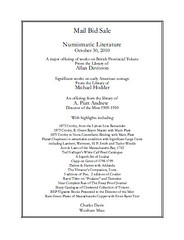 The bellwether of the market has always been the plated Chapman catalogues, and yesterday's sale was no exception. A near mint H.P. Smith brought $8500 ($9800 with the buyer's premium). Taylor Windle brought $4250 ($4900 w/bp), a mint David Wilson $1550 ($1800), a Parsons with images cut from 3 plates brought $1200 ($1380) and a Lambert sale fetched $1400 ($1600).
The bellwether of the market has always been the plated Chapman catalogues, and yesterday's sale was no exception. A near mint H.P. Smith brought $8500 ($9800 with the buyer's premium). Taylor Windle brought $4250 ($4900 w/bp), a mint David Wilson $1550 ($1800), a Parsons with images cut from 3 plates brought $1200 ($1380) and a Lambert sale fetched $1400 ($1600).
Other highlights were a Crosby Early Coins of America in Crosby's binding at $3,000 ($3450) and A. Piatt Andrew's two-volume set of BEP Portrait & Vignettes at $5,000 ($5750). We should have the price list on our Vcoins web site Tuesday.
Charles Davis
Numismatic Literature
P.O. Box 547
Wenham, MA 01984
Tel: (978) 468 2933
Fax: (978) 468 7893
www.vcoins.com/ancient/charlesdavis
LAKE BOOKS 105TH MAIL-BID SALE CLOSES NOVEMBER 30, 2010
Lake Books announces that its 105th mail-bid sale of numismatic literature is now available for viewing on their web site at www.lakebooks.com/current.html .
The 546-lot sale features selections from the library of prominent numismatic luminary Eric von Klinger. The various facets of the collection include reference material on United States and World coinage, Medals and Tokens, Paper Money and Guide Books. The auction closes at 5:00 PM (EST) on Tuesday, November 30, 2010. Please note that there is a change in the "Terms of Sale". Bids that are entered in "cents" will be rounded up to the nearest half-dollar amount.
Remember to bid early as ties are won by the earliest bid received. Bids may be placed via email, fax, telephone or US Mail.
Good luck with your bidding, Fred
Lake Books
6822 22nd Ave. N.
St. Petersburg, FL 33710
727-343-8055 Fax 727-345-3750
NEW BOOK: LIBERTY SEATED HALF DOLLAR VARIETIES, VOLUME II, CARSON CITY
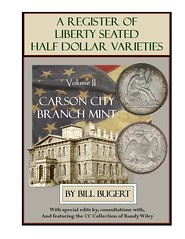 A Register of Liberty Seated Half Dollar Varieties, Volume II, Carson City Branch Mint
By Bill Bugert
A Register of Liberty Seated Half Dollar Varieties, Volume II, Carson City Branch Mint
By Bill Bugert
- With Special Edits by, Consultations with, and Featuring the CC Half Dollar Collection of Randy Wiley
- Details all known Carson City Branch Mint half dollar die marriages (96) with narratives, photo diagnostics, rarity ratings, background information, etc.
- Includes over 900 close-up and full coin photographs
- Has 220 pages in 8.5 x 11 inch size
- Printed on high quality 100# anthem gloss paper
- Available in 3-hole punched format (ready for your binder) or plastic comb binding format
- Priced at $50 postpaid (please specify format) U.S. delivery
Available from the author at:
Bill Bugert
1230 Red Rock Road
Gettysburg, PA 17325-6927
NEW BOOK: CANADIAN COIN DIGEST
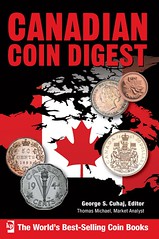 A comprehensive reference book on Canadian coins is now available from numismatic publishing leader Krause Publications.
A comprehensive reference book on Canadian coins is now available from numismatic publishing leader Krause Publications.
Produced by the Standard Catalog of World Coins staff, Canadian Coin Digest covers everything from the earliest unified coins of 1858 to today's innovative releases from the Royal Canadian Mint. The affordable, portable reference features:
- More than 1,200 photographs and illustrations
- Thousands of up-to-date value listings reflecting current precious metals prices
- Accurate mintage figures, KM identification numbers and detailed descriptions
- Comprehensive coverage of new issues from the prolific, innovative Royal Canadian Mint
The book is edited by George S. Cuhaj, with market analysis from Tom Michael.
For more information visit www.shopnumismaster.com/product/canadian-coin-digest/world-coins
NEW BOOK: NEW ZEALAND HISTORY NOTED
 I have just launched a book on New Zealand Bank notes produced for the Reserve Bank of New Zealand. It is called "New Zealand History Noted". I have put a website together to allow people to have a look at the book as there are three sample pages on the site. The website is
nzhnoted.weebly.com
.
I have just launched a book on New Zealand Bank notes produced for the Reserve Bank of New Zealand. It is called "New Zealand History Noted". I have put a website together to allow people to have a look at the book as there are three sample pages on the site. The website is
nzhnoted.weebly.com
.
The book looks at all six issues of notes produced for the bank as well as topics such as Counterfeits, War Emergency Notes and Replacement notes.
Book Price
New Zealand - NZ$79.99 and NZ$6.00 P&P
Australia - A$70.00 and A$8.00 P&P
United Kingdom - £40.00 and £12.50 P&P
USA - US$60.00 and US$15.00 P&P
BOOK REVIEW: 1824 JR-2 - THE 6TH RAREST CAPPED BUST DIME DIE VARIETY
 Jim Koenings' new work is a 45-page monograph, 8.5" x 11" format, spiral bound with cardboard covers protected with plastic sheets. The meat is in the Ranking section (pages 5-38) where individual specimens of this die vsriety are listed one to a page with large color photographs of the obverse and reverse. Each listing includes condition census rank (from 1 to 33), grade, current owner and pedigree (where known), notes, and photo credit.
Jim Koenings' new work is a 45-page monograph, 8.5" x 11" format, spiral bound with cardboard covers protected with plastic sheets. The meat is in the Ranking section (pages 5-38) where individual specimens of this die vsriety are listed one to a page with large color photographs of the obverse and reverse. Each listing includes condition census rank (from 1 to 33), grade, current owner and pedigree (where known), notes, and photo credit.
It's an oversimplification of course, but there are two main kinds of collectors, and thus two main kinds of one-coin numismatic books. One kind of collector is attracted to numismatics for the history and stories behind their coins. Books like The Fantastic 1804 Dollar" and "Million-Dollar Nickels" (about the 1913 Liberty Head Nickels) fall mainly into this category.
Another kind of collector is attracted to the intricacies of artwork and detail in coins themselves. Thus books like the Clapp/Newcomb/Sheldon works on Large Cent varieties, and the Beistle/Overton works on Half Dollar varieties.
Koenings' monograph is clearly in the latter category, taking earlier die variety studies to the next logical step - a detailed look, specimen by specimen, at individual examples of one variety. It's painstaking work, and Jim's efforts have laid the groundwork for the studies of future generations of collectors.
As Jim notes in the "How This Book Came About" section, he discovered early on the importance of identifying specific examples of the coin as they exchanged hands over the years. Indeed, this type of detailed study was a key part of "The Fantastic 1804 Dollar" book, one of my all-time favorites.
Doing the research on this book, I discovered how really important pedigree information has become. Many times the same coin is reported in different grades. For instance in the 1st JRCS Dime Census in November, 1987, there were 6 specimens reported (30, 15, 12, 8, 8, 6). Jules Reiver's VF-30 coin was sold to Jim Matthews as a VF-25 coin in Heritage's Sale of January, 2006. JRCS #010's F-12 coin was sold through Coin Galleries, 7-18-90 Sale as a VG coin. Then later again the same coin was sold by Coin Galleries, 7-14-93 Sale as a Fine coin.
Allen F. Lovejoy reported a VG specimen that was eventually purchased by Donald Peetz, who submitted it to ANACS and is now graded G-4. John McCloskey's G-6 coin was sold to Russell J. Logan and later sold in the Logan Duplicate Sale, May 13, 2006, as a G-4 coin. William Subjack's VG-8 is now owned by Mike Sherrill. The location of H. Roland Willasch's F-15 is still unknown.
The book includes close-up photos of the key diagnostic points for attributing the variety. All of the photos are quite useful to collectors of the series.
If there's something missing from the book, it's prices (or "values"). As a non-collector of varieties, I'm clueless. Are these $100 coins? $1,000? $10,000? Even a general guide would help, as would a compilation of sale prices where known specimens changed hands in an auction. In the Summary, a couple sale prices are mentioned, but only in passing.
Despite that one omission, I think this is a a very useful work for collectors of the Bust Dime series, and a good example for single-variety monographs on other coins.
If you would like a copy, you can send a check or money order for $24, which includes shipping and packaging, to:
Jim Koenings
P.O. Box 2382
Riverside, CA 92516
Jim kindly forwarded me some text from his manuscript, and I've quoted several paragraphs below. Thanks, and congratulations on a nice product.
At the next coin show, I purchased 4 or 5 more Capped Bust Dimes in low grade and decided to see how inexpensive a set of "Red Book" varieties I could complete. I then noticed that a couple of 1835 dimes were different, but there was only one variety listed in the Red Book. So I asked one coin dealer if he knew of any reference book on dime varieties and he suggested that I purchase a copy of "United States Dimes" by A. Kosoff.
So I purchased, through the mail, a copy of the Revised Edition 1964 with current values. It was very disappointing as their were no real descriptions, for instance Kosoff listed two varieties for 1835, one with a small 0 in 10 C and one with a large 0 in 10 C. My real answer came in the January 9, 1985 issue of "Coin World" when they announced the new book "Early United States Dimes 1796-1837" by David J. Davis, Russell J. Logan, Allen F. Lovejoy, John W. McCloskey and William L. Subjack (EUSD).
I immediately purchased the book and the hunt began. The authors of this book formed an organization that they called the John Reich Collectors Society (JRCS) and I became a member the first chance I had. Its first publication "John Reich Journal" was printed in January, 1986. Persons interested in joining JRCS may email Brad Karoleff at bkaroleff@yahoo.com for additional information, or write to JRCS, P.O. Box 135, Harrison, OH 45030.
Over the next 15 years, I specialized in collecting Capped Bust Dimes by variety, finding 120 out of 122 known. In June, 1988, I found my first specimen of 1824 JR-2, it graded AG-3.
Sometime in the year 1985, I went to a local coin show in California. At that coin show, I met Brian Greer. For some reason, Brian pointed out to me, in my copy of "EUSD", that the 1822 JR-1 variety was the same rarity as the 1824 JR-1, R-3 (201 to 500 known). So I decided to go out of my way and look for 1824 dimes.
At my next dentist appointment, I mentioned that fact to my dentist, along with the fact that if we bought all of the 1824 dimes we could find, we might also find a few 1824 JR-2 dimes. So for nearly 20 years, my dentist gave me money each month to purchase 1824 dimes and other rare items.
In the nearly 20 years that we had the partnership, I had purchased one 1824 JR-2, attributed, for my personal collection (Coin Galleries, 7-14-93, Lot 2264) and found 3 others, a F-12 specimen and two AG-3 specimens. Not quite what I had hoped.
During this same period, I came upon another die variety that I thought was very underrated, 1827 JR-2. I was so fascinated with the 1827 JR-2 that I decided to do a pictorial census on it. It took me 14 months to complete, but by January, 2010 I had my first book printed. The book was so successful that I decided to do a second book, this time a pictorial census on 1824 JR-2 dimes.
Having accumulated hundreds of 1824 dimes and keeping photos and records of others that I didn't purchase, I now have records of nearly 700 specimens. Later in this book you will find the grade distribution of all 1824 dimes. I will compare the grade distribution for 1824 JR-2 listed in this book with the grade distribution of 1824 JR-1 dimes.
To read the earlier E-Sylum article, see: NEW BOOK: 1824 JR-2 - THE 6TH RAREST CAPPED BUST DIME DIE VARIETY (www.coinbooks.org/esylum_v13n43a06.html)
THE BOOK BAZARRE
NOVEMBER 18, 2010 AUCTION HIGHLIGHTFeaturing a 17th Century Engraving of the St. Patrick's Coinage. An exceptionally fine example of this numismatic landmark work, with a remarkable pedigree. From the library of Rogers Ruding, it was purchased by Edward Hawkins on November 27, 1838 at the auction sale of coin dealer Matthew Young. Beyond comprising the first major history of English medals written in English, it is also thought to be the earliest publication to depict a St. Patrick's copper.
141 W JOHNSTOWN ROAD, GAHANNA OH 43230-2700
(614) 414-0855 • df@numislit.com • GFK@numislit.com
MORE ON MASAMICHI OKA AND JAPANESE EDITIONS OF WHITMAN COIN BOOKS
The E-Sylum just keeps getting better with each issue. It's almost addictive and we could not live without it. Keep up your great efforts. I assure you that your dedication and hard work is much appreciated by all of your readers.
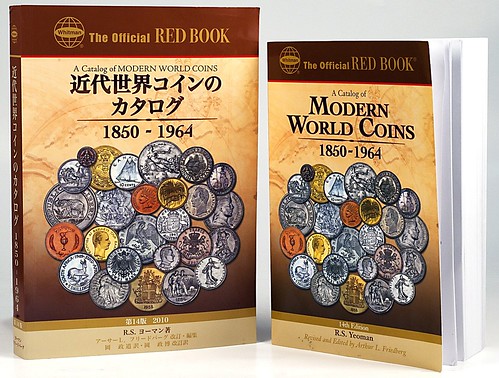
The article in the last issue of The E-Sylum about the new Whitman Catalog of Modern World Coins brought back some fond memories of years ago when Dick Yeoman and I worked with Masamichi Oka on several projects from 1970-1977. He was a fine gentleman and visited our offices in Racine a couple of times while we were working on the books. I still treasure a lovely international clock that he gave to me on one of his visits. Later, I was pleased to get to know his son Masahiro on his visits to the conventions in this country.
At that time the following editions of Whitman coin books were translated and published for sale in Japan: Modern World Coins 9th, 10th, and 12th. Current Coins of the World 3rd, 4th, 5th, 6th, and 7th. I have copies of each of these in my library. All but MWC 10th, and CCW 3rd are inscribed to me by Masamichi Oka. I do not remember why I do not have the 11th edition of MWC, or if it was ever published. As far as I know none of these editions were sold in the states so I would assume they are all rather scarce in this country.
My quiz question has already stumped Ken Bressett, who writes:
You pose a tough question about German translations. I can't think of a one. I do however, have some special Whitman books that may be of interest to E-Sylum readers. The Guide Book of Mexican Decimal Coins by Ted Buttrey was translated into Spanish as Guia de Las Monedas Decimales Mexicanas in the 1960's, and A Guide Book of English Coins (Bressett) was ‘translated' into ‘British English' and priced in pounds sterling for several editions from 1966-1968. A pirated edition of Klawans' An Outline of Ancient Greek Coins was published in Greek sometime around 1970.
To read the earlier E-Sylum article, see: NEW EDITION: A CATALOG OF MODERN WORLD COINS, IN JAPANESE (www.coinbooks.org/esylum_v13n43a07.html)
SOME SPICY READING ON THOSE OLD MINT REPORTS
There is nothing so dead as an old book. Well, that might be true of a piece of popular pulp fiction now forty or fifty years old, but what about a dry as dust piece of statistical compilation from a past century ?
The time is 6am and the day of a dealer in numismatic books is a long one, though only because I wake early. As a reader of this journal you are a self-confessed bibliophile, so you may know what I mean.
A bibliophile too, I have been fascinated by the written word ever since I could read, and there is only a very short part of my life when I can remember not being able to read. Well, actually, I can't really remember a time when I couldn't read. All that I can remember is that I was about to go into Miss Averill's class and we had been warned in advance that Miss (married women in those days could not be teachers) Averill stood no nonsense and that we would have to learn some difficult words, that, at least was what Miss Carter in the reception class told us.
Miss Carter was young, pretty and lovely, so what she said must be true. Miss Averill, on the other hand was old, had a moustache, and a double chin that wobbled when she blew the whistle in the playground, or got angry with someone. My infant brain wondered about difficult words, but all that I remember now is Miss Averill's double chin and that unlike Miss Carter, who smelled, subtly of perfume and things nice, Miss Averill smelled of mothballs and Miss Averill.
Two years later when I was six and could read fairly fluently, I began to read anything and everything I could lay my hands on, from newspapers to sauce bottle contents labels if there was nothing else around. It was then that I learned about difficult words. What was an anchovy, and why was there anchovy in sauce ? ‘Don't be daft', I thought, when Mam told me that it was a fish. You don't put fish in HP sauce, even a six year old knows that, but in those days I had never heard of garum, and curiously, my computer dictionary, although it knows about ‘anchovy', it hasn't heard of ‘garum', when I can think of at least two meanings for it – but that's the result of reading widely for the last sixty-many years.
But in those days, life and words were often confusing. For years our milk had been delivered by an old man who came to the back door with a churn and our daily pint was ladled straight from his churn into our jug. Then it all changed and milk came in bottles. The bottles had CWS in big letters on them, now six-year olds don't know what acronyms are, much less six-year olds back in 1948, but this one knew that in Welsh, the letter W is a vowel (well, it's called double-u, isn't it ?) In Welsh it is sounded rather like the oo in shoot. So, knowing that milk came from cows, it seemed only natural that that's what appears on the bottle, so for a while I spelled the animals that give us milk as cws.
But CWS isn't how you spell cows, even though it is not far off, and the Welsh word for cows, and the word for milk are certainly nothing like CWS, so I was to learn that didn't fit either, the more so because the word for milk in welsh is quite different in the south of Wales from the word that I would now use here in the north of Wales. When I asked, I was always asking, I was told that CWS stood for Co-operative Wholesale Society.
What does “Co-operative mean ?” I asked. “You want to know too much” said my mother who was more aware of the quarterly dividend she got from the local biggest and cheapest shop in town than the principles and practices of the Co-operative movement. I was later to find, of course, that whilst some questions could be answered in a few words, or by a simple ‘yes' or ‘no', other questions, sometimes even the same question could take up a whole book.
I am still asking questions, and still reading, of course. Reading remains fun and it still doesn't matter what it is, though these days I don't chew my pencil whilst I read. This is why I cannot resist reading the books that I put onto our database so that they can appear on our new website. The latest one that comes to mind shows that there are avenues into which numismatics takes us that are fascinating, even though one might think that they are nothing more than compilations of statistics that were dead in the water a century ago.
What have I found to read and why ? The second question is best answered first. I have been adding to each listing, a description of the book. This has necessitated reading some of those about which I knew nothing – and in any case, who, picking up a book can resist opening it and taking a quick peek ? What have I found ? Well, about 4000 items that will appear on our new website when it is up and running.
One of the items was : Annual Report of the Comptroller of the Currency to the Second Session of the Forty-seventh Congress of the UNITED STATES.? December 4, 1882.
Published in Washington, in 1882, it is a PB and has 94 pages. Now you might suppose that the usual rule applies and that the longer the title of a book, or an article, the more boring it is, or that something with a title like that is by its very nature something that would render even a hardened, questioning bibliophile as rigid as the proverbial ramrod. But no ! It is full of interesting information, not only to to someone keen on knowing how many coins of which type were struck and at which mint in that financial year, but it is full of socially important stuff too. Immediately springing to one's notice is the chapter entitled: National Bank Failures.? Three banks had been placed in the hands of the receivers.?
One comment is interesting: viz. the directors of the Pacific National Bank of Boston undertook to make good the impairment of its capital stock... now there's a thought with which to conjure, why has that not happened in the current bank collapses, in which the directors seem to have gotten away free of all encumbrance ??
Another bank, the First National Bank of Buffalo, had had its funds misappropriated by its president and had had to go into receivership. That must have made the headlines, if only in Buffalo. Who was he ? What had he been doing ? How had he been doing it ? Was it gambling, supporting his aged mother, other women, drinking or what ? How much did he steal ? Did he get away with it ? Oh !? And there's loads more. Of course, there are no graphic details in the book, only the raw facts, but one is tempted to find out more. If I were a journalist, or had time to spare, there could be an article there.
In the same handful of books to be added, there was one that appeared to promise even less, than the Annual Report of the Comptroller of the Currency. It was the
Report of the Commissioner of the Imperial Mint for the Year Ending the 30th of the 6th Month of the 15th Year of Meji (30th June 1882).
This is clearly a clone of western Mint Reports, and it gives, as they do, all the statistics for the year: import of gold and silver bullion, copper, amounts refined, numbers of coins made, and the like, but it goes to extra lengths, because it reports on the health of the employees of the Imperial Mint. We learn that one of the officials of the Assay Office and Refinery was suffering from gonorrhea ! In other years of the same Report similar statistics are given for other sexually transmitted diseases, including syphillis.
Anonymity might be taken seriously nowadays, but in one of the instances, where the particular department was split into workers and officials, we learn that one of the officials was suffering from something unmentionable in polite society at the time. If it had been one of the 46 workers there would have been some chance of remaining anonymous, but as there were only two officials in that department, serious embarrassment cannot have been far away after the report was published.
We also learn that Imperial Mint did not trust their own assay department, for when the equivalent of the Trial of the Pyx was carried out samples were also sent to the US and the Royal Mint in London, where analyses were carried and the results compared. Fortunately, they were found to be satisfactory.
Given all of the books that have had to pass through my hands for me to say something about them, it is a miracle that I have not shut down completely in a reverie of reading old books, and some new ones too !
The all-singing, all dancing website goes live in about a week. You will find it at www.galata.co.uk .
THE BOOK BAZARRE
PRINCETON 'MONEY ON PAPER' EXHIBIT LECTURE AND RECEPTION HELD
Regarding the exhibition "Money on Paper: Bank Notes and Related Graphic Arts from the Collections of Vsevolod Onyshkevych and Princeton University," David Gladfelter writes:
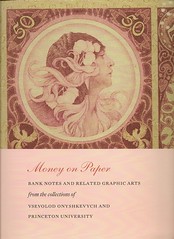 Special events were held on October 17 in connection with this exhibit. Mark Tomasko presented a well-illustrated lecture on the topic “The Art of Bank Note Engraving” sponsored by Friends of the Firestone Library. This was followed by a wine and cheese reception, and a tour of the exhibition led by the curator, Dr. Alan M. Stahl.
Special events were held on October 17 in connection with this exhibit. Mark Tomasko presented a well-illustrated lecture on the topic “The Art of Bank Note Engraving” sponsored by Friends of the Firestone Library. This was followed by a wine and cheese reception, and a tour of the exhibition led by the curator, Dr. Alan M. Stahl.
Accompanying him were Vsevolod Onyshkevych, a Princeton engineering alumnus who contributed a selection of modern European bank notes to the exhibit; Robert M. Peck, co-author with Eric P. Newman of the essay on the Gideon Fairman engraving after Audubon's drawing of a grouse, who spoke briefly about that portion of the exhibit; and current student Francis Musella '13 who contributed an essay on Benjamin Franklin's nature printing.
With several members of the New York Numismatic Club in attendance, an impromptu dinner at a local restaurant followed, including the speakers and other participants. A great (not just good) time was had by all.
Dr. Stahl will again lead curatorial tours on November 21 and December 12. The exhibit closes January 2.
To read the earlier E-Sylum article, see: NEW BOOK AND EXHIBIT: MONEY ON PAPER (www.coinbooks.org/esylum_v13n34a07.html)
ON MATERIALS USED IN COINS AND MEDALS
The list of materials given by Tony Clayton as having been used in making coins and medals is extensive and fascinating, but I've got a few possible add-ons, particularly where medals are concerned...I can even offer some attached scans as "proof"
Wood is used for many medals, and even for wooden nickels (17th Century German medal of an unknown man)
Then, too, there's sawdust, mixed (it is said) with blood to form Bois Durci (19th Century French medal of Abee L'Epee)
Medals are also pressed into Horn (Pope athanasius)
A Russian mining medal of the 60s incorporates Germanium among other metals
Another Russian medal of 1961 to celebrate German Titov's flight is made of Rocket nose-cone material
Maybe it's not a medal, though it sure looks like one, and it's made of 19th Century French laundry Soap
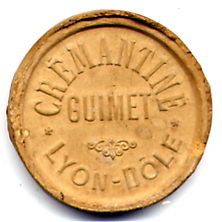
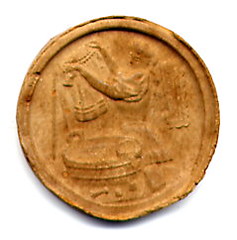
Also, there's a category of souvenir medals made of Lava (from Vesuvius in 1843)
Finally there are edible medals which, while covered in gold foil, are really Chocolate (for Hanukkah)
And even drinkable currency, namely pre-Russian Revolutionary pressed Tea Bricks which in whole or part circulated as money in Mongolia and China.
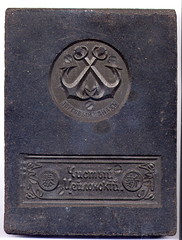
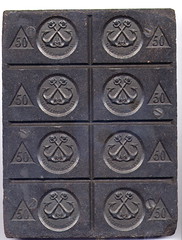
To view a slide show of Ira's images, see: www.flickr.com/photos/coinbooks/sets/72157625160375603/show/
To read the earlier E-Sylum article, see: FEATURED WEB SITE: METALS USED IN COINS AND MEDALS (www.coinbooks.org/esylum_v13n43a29.html)
QUIZ ANSWER: THE MEDAL OF THE MONTH FOUNDATION
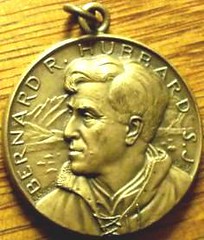
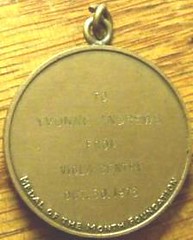
I bought the Hubbard medal. The inscription on the back is:
Yvonne Andrews
From
Viola Gentry
Oct.30,1973
Viola Gentry was one of the founding members of the Ninety-Nines, the female pilots organization. Viola Gentry was also one of the donors who made the striking of this medal possible. Yvonne Andrews is still a mystery
Bernard Hubbard, SJ was head of the Geology Dept at Santa Clara University but spent most of his time in Alaska or on the Lecture Circuit in the U.S. raising money to go back to Alaska. His lectures illustrated with motion pictures were a huge draw in the lower 48 and greatly increased Alaska awareness in the U.S.
Gold and bronze versions of the medal are in the archives of Santa Clara University, and there is a version of the medal with a capsule biography on the reverse. I have a copy of the cartoon strip that goes with the medal. There are also two plaques in existence with ten-inch galvanos of the obverse and the reverse mounted side by side on wood.
Felicity was one of eight children of Vincent & Margaret Ann Meyer Buranelli of Temple, Texas. She lived at 15 W. 67th St., NY, NY, from at least 1937 until her death. She was born Dec.6, 1893 and died Nov.17, 1979. She was the third of eight children. She never married.
The first mention I find of Felicity is as a passenger on the First Airliner on a flight to Washington D.C. on 9/19/19. This First Airliner was designed by her brother Vincent Buranelli and was flying to Washington to seek Government support.
Next, Felicity turns up as an assistant to her “Aunt” Anne Meredith Kitson (1855-1937). Anne was the widow of Samuel J. Kitson, a well-known British sculptor who died in 1906. Anne was also a sculptor and she completed a life-size statue of Christ the King left unfinished by her husband. In 1937 this plaster statue was cast in bronze and shipped to Father Bernard R. Hubbard, S.J. in Alaska. He installed the statue at the top of King Island facing Russia. Anne died just before the bronze was cast and it fell to Felicity to carry out all the arrangements.
Next thing I found was an application for a display holder for coins and medals filed Nov. 5, 1938 and issued as patent #2,258,535 on Oct.7, 1941 to Felicity A Buranelli. This holder is designed to display both sides of a group of coins or medals of the same or varying sizes and “includes the provision of means in the board structure for fittingly engaging disks of transparent material to cover the coin or medal surfaces for their protection against atmospheric action”. Maybe this is the godfather of the slab.
In the 9/28/41 New York Times pSM18.there is a small blurb that tells her medallic story.
For some years Miss Felicity Buranelli has worked on the idea that boys and girls could learn about great men and women in American life and history and at the same time possess fine examples of sculpture by collecting a series of medals. Her “Medal of the Month Club” has been adopted by schools and other groups. All medals are executed by well-known artists and a committee passes on the original plaques before the medals are struck. Series 1 is devoted to aviation, including a Wright Brothers medal and one of Amelia Earhart. We learn that the Gramercy Boys Club has awarded the medals to winners of its contest in model planes and gliders.
In another NY Times piece dated 10/11/53 pS12, the writer stated:
Miss Felicity Buranelli, founder of the Medal of the Month Club, ….has been distributing medals an inch and a half in diameter that are miniatures of large plaques representing famous persons in flying. The original ten-inch plaques are the works of sculptors like Brenda Putnam and Carl Schmidt. The aviation figures include Frank Hawks, Glenn H. Curtiss, Amelia Earhart, Gen. “Billy” Mitchell and the Wright Brothers.
My research indicates that Miss Buranelli produced 10 medals over about 30 years. She concentrated on major figures of aviation but there was one interesting deviation: Father Bernard R. Hubbard, SJ. Felicity first came into his world in 1937 when he installed the Kitson-Christ figure on King Island in Alaska. She wrote an article about that experience for Guideposts in 1950. At about that time Hubbard came to New York and she invited him to her studio to sit for sculptor Carl Schmitz for a medal to celebrate his Silver Jubilee as a priest.
I think it can safely be said that the Felicity Buranelli Medal of the Month Club had a very slow production schedule. It seems inherent in the name of her Club that a new medal would be produced every month. Certainly there have been other medal programs that were time sensitive. The Society of Medallists did two issues a year for three quarters of a century. The Franklin Mint developed the monthly medal program into a fine art. After researching Miss Buranelli, I think she was more value sensitive than time sensitive and considered her medals to be merit badges of achievement for her youthful market. I don't think she made any particular effort to actually produce a medal a month.
To read the earlier E-Sylum article, see: QUERY: MEDAL OF THE MONTH FOUNDATION (www.coinbooks.org/esylum_v13n43a17.html)
WAS HOBBIES MAGAZINE NUMISMATIC EDITOR A 'GHOST'?
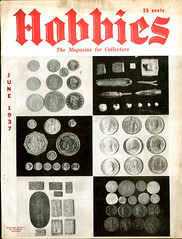 The editor of the Numismatics section of Hobbies magazine for nearly 20 years was Frank C. Ross Sr. He lived in Kansas City, Missouri, where, as a teenage coin collector, I lived and became active in the area. I joined the local coin club, Heart of America Numismatic Association, in 1946. Club members knew of Frank Ross, but as I remember none had ever met him. He was somewhat of a numismatic ghost in his own city.
The editor of the Numismatics section of Hobbies magazine for nearly 20 years was Frank C. Ross Sr. He lived in Kansas City, Missouri, where, as a teenage coin collector, I lived and became active in the area. I joined the local coin club, Heart of America Numismatic Association, in 1946. Club members knew of Frank Ross, but as I remember none had ever met him. He was somewhat of a numismatic ghost in his own city.
By 1946 at age 16 I had decided what I wanted to do in life: be a numismatic writer and editor. And here was a famous numismatic writer and editor in my own city! Frank Ross didn't die until 1955, but we never met.
This brings to mind the vast number of numismatic personalities who are prominent in the field through their writing, but who are not active in local clubs, in regional or national numismatic organizations, who don't attend numismatic functions. I don't believe it is an anti-social reason, but could it be that these writers consider such local or social numismatic activities a waste of their time?
There are dozens, perhaps hundreds of numismatic authors who I have never met -- and whose acquaintance I would like to make. Our paths have never crossed. But some who are so unfamiliar that no one seems to have known them personally.
Maybe I am falling into that category myself. For four decades I tried to attend every national ANA convention (I think the total number to date is 29), attend as many regional conventions as possible, and join every local coin club possible. As I moved around the country (in military service, college, and various employments) I delighted in this numismatic camaraderie and cherished the occasion to learn something new with other collectors.
I just counted my membership cards to learn I was a member of local coin cubs in 34 cities (but some of those were honorary where perhaps I gave a talk one time and didn't attend regularly). But my attendance is diminishing because of age and difficulty of traveling. I am down to only one local club, Litchfield County Coin Club. Certainly this is not for lack of interest or wishing to meet new collectors.
I could name a dozen numismatic "ghost" writers who I would like to meet and chat with in person. If you could spend an evening with a favorite numismatic author you have never met, who would it be?
SCRAPBOOKS AS RESEARCH SOURCE MATERIAL
Scrapbooking is quite the popular hobby today, but it's hardly a new idea. People have been compiling images, memorabilia, and the written word since these things existed. While exploring yet another of the American Antiquarian Society's hidden gems, I found we have a wonderfully rich scrapbook collection.
You never know what you're going to find in a scrapbook, which is what makes them such amazing resources. The contents, nature, and character of each scrapbook depends entirely on the creator. Topics can be anything from flowers, to local history, to simply random newspaper clippings someone found interesting.
 Just the other day, a reader was looking for resources about P.T. Barnum, and amazingly, we have a scrapbook done by a person who was interested in what he termed “Freaks of Nature.” Hence we were able to provide a scrapbook filled with various images, newspapers articles, fliers (like the one pictured to the left) and clippings from published works, many about P.T. Barnum's circus. On occasions such as this, a scrapbook can end up being one of the best resources for a project.
Just the other day, a reader was looking for resources about P.T. Barnum, and amazingly, we have a scrapbook done by a person who was interested in what he termed “Freaks of Nature.” Hence we were able to provide a scrapbook filled with various images, newspapers articles, fliers (like the one pictured to the left) and clippings from published works, many about P.T. Barnum's circus. On occasions such as this, a scrapbook can end up being one of the best resources for a project.
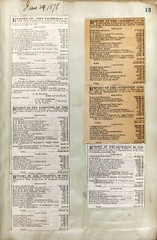 Another interesting scrapbook from our collection is a compilation of various Worcester banks' dividend earnings in the late 19th century. While certainly not as exciting or intriguing as the “Freaks of Nature” scrapbook, it's a great way to get a localized glimpse into the economy and banking industry of the time.
Another interesting scrapbook from our collection is a compilation of various Worcester banks' dividend earnings in the late 19th century. While certainly not as exciting or intriguing as the “Freaks of Nature” scrapbook, it's a great way to get a localized glimpse into the economy and banking industry of the time.
Imagine the time it would take a modern day researcher to go through issue after issue of newspapers, looking for articles and statements from local banks. But thanks to scrapbooks, if you happen to have the same random interest as a scrapbooker 100 years ago, you're in luck!
So to all you scrapbookers out there – keep it up! You could be compiling the great primary resources of tomorrow.
To read the complete article, see: Scraps of the Past (pastispresent.org/2010/good-sources/scraps-of-the-past/)
AUDIT SHOWS NATIONAL ARCHIVES RECORDS IN DANGER OF BEING LOST
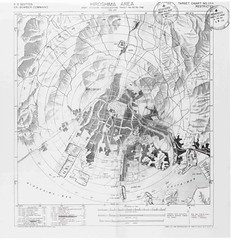 An audit prompted in part by the loss of the Wright Brothers' original patent and maps for atomic bomb missions in Japan finds some of the nation's prized historical documents are in danger of being lost for good.
An audit prompted in part by the loss of the Wright Brothers' original patent and maps for atomic bomb missions in Japan finds some of the nation's prized historical documents are in danger of being lost for good.
Nearly 80 percent of U.S. government agencies are at risk of illegally destroying public records and the National Archives is backlogged with hefty volumes of records needing preservation care, the audit by the Government Accountability Office found.
The report by the watchdog arm of Congress, completed this month after a year's work and obtained by The Associated Press, also found many U.S. agencies do not follow proper procedures for disposing of public records.
Officials at the National Archives, which houses the Declaration of Independence, the U.S. Constitution and other treasured documents at its Washington rotunda, had no immediate comment Tuesday on the findings.
The report comes more than a year after news reports of key items missing at the nation's record-keeping agency. Some of the items have been missing for decades but their absence only became widely known in recent years.
The patent file for the Wright Brothers flying machine was last seen in 1980 after passing around multiple Archives offices, the Patents and Trademarks Office and the National Air and Space Museum.
As for maps for the bombs dropped on Hiroshima and Nagasaki, military representatives checked them out in 1962, and they've been missing ever since.
The GAO report did not specifically mention those or other examples of missing items including Civil War telegrams from Abraham Lincoln, Eli Whitney's cotton gin patent and some NASA photographs on the moon.
To read the complete article, see: Audit Shows Records at National Archives in Washington at Risk of being Lost for Good (www.artdaily.org/index.asp?int_sec=2&int_new=42116)
THE BOOK BAZARRE
“100 Greatest American Medals and Tokens.”QUERY: WAS BOWERS' THREE CENT FEUCHTWANGER THE STICKNEY SPECIMEN?
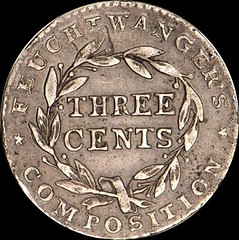 I have been working hard researching the Feuchtwanger three cent pieces and found that the 1907 Chapman Stickney sale included an 1837 L-118 (Lot 2027) plate image appearing on page 166, noted as a 'slightly bent planchet'.
I have been working hard researching the Feuchtwanger three cent pieces and found that the 1907 Chapman Stickney sale included an 1837 L-118 (Lot 2027) plate image appearing on page 166, noted as a 'slightly bent planchet'.
In studying the image, which is somewhat degraded from the process of digitally posting the auction catalog on the web, numerous small hits and dark spots seem to match you're the piece exactly. Attached is a GIF image I put together using the Chapman image and my photograph. Details around the eagle's head, and on the rim from 9 o'clock to 12 o'clock seem to be a perfect match.

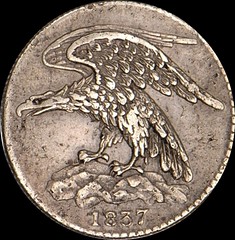
Does anyone have a copy of the plated Stickney catalog, and would you be able to check, compare images and give me your opinion? Is this indeed the Stickney specimen?
PETER ROSA APPRENTICE CHARLES DOYLE ANNOUNCES COIN REPLICA FIRM
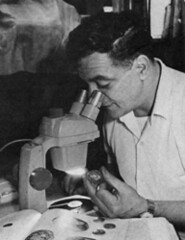 Coin Replicas, Inc., a metallic art reproductionist of museum-quality, rare and ancient coins, today announced the company's official launch. As coin experts and historians, the company specializes in replicas from the rarest and choicest Ancient Greek, Roman, Biblical and Colonial & Early American coins.
Coin Replicas, Inc., a metallic art reproductionist of museum-quality, rare and ancient coins, today announced the company's official launch. As coin experts and historians, the company specializes in replicas from the rarest and choicest Ancient Greek, Roman, Biblical and Colonial & Early American coins.
“During a recent event at Heritage Auctions in Boston, a 1652 New England Shilling, the first coin struck in British Colonial America, sold for more than $400,000. We make a precisely crafted replica of that coin for about $20. At that price point, virtually anyone can hold, own and appreciate a piece of history,” says Charles Doyle, president and metallic artist of Coin Replicas.
Coin Replicas' numismatic art reproductions are uniquely beautiful and accurately detailed in comparison to their ancient originals. They achieve this quality by starting with the best casts and molds created from the original coins by the late Peter Rosa, known as one of the greatest manufacturers of coin replications in the United States.
“After apprenticing with my uncle, Peter Rosa, for many years, and now coming back to my art full-time as the principal of Coin Replicas, is a dream come true,” says Doyle. “My purpose is to continue Peter's legacy and to make the art of the ancients available to the collector of all levels and means.”
Replicating Rosa – The Greatest Coin Reproductionist of the 20th Century Peter Rosa is regarded by many in the numismatic world as one of the greatest coin reproductionists of the 20th Century. Unfortunately, at the same time as his business was achieving global success, coin dealers, followed by the press, went on a witch hunt in the 1960s and began opposing Rosa's art in the name of forgery.
In the late 60s, Rosa's company, Becker Reproductions, Inc., was selling nearly a quarter of a million coins in more than 40 countries worldwide. And although resistance was building specifically from coin dealers, there were many connoisseurs of coin art, collectors and even the American Numismatic Society contracted Rosa to replicate certain rare and valuable coins in the ANS collection.
The Undocumented Rosa Coin Replicas of Early America Rosa has been the subject of numerous articles and books, including Wayne Sayles, Classical Deception. Interestingly, Rosa's vast collection of Colonial and Early American coin replicas have gone widely unreported and virtually undocumented. His nephew and long-time apprentice, Charles Doyle, is reproducing and formally cataloging these rare and historic numismatic treasures in a reference guide. The official guide will be available free to collectors and historians in 2011 via Doyle's website, CoinReplicas.com.
Employing the unique coin reproduction skills and techniques of Peter Rosa, Charles Doyle established Coin Replicas, Inc. He carries on his uncle's legacy through fine metallic art reproductions of museum-quality, rare and ancient coins. For more information about Coin Replicas, please visit our website at http://www.coinreplicas.com .
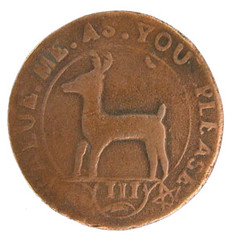

To read the complete press release, see: Coin Maker Recreates History Through Rare and Ancient Coin Replicas (www.prweb.com/releases/2010/10/prweb4697824.htm)
To read the earlier E-Sylum article, see: PETER ROSA'S COIN REPLICAS (www.coinbooks.org/esylum_v13n01a20.html)
NOTES FROM E-SYLUM READERS: OCTOBER 31, 2010
Georges Depeyrot writes:
Perhaps some would be interested in joining www.academia.edu , a network of scholars and (to my point of view) a nice way to exchange photos, news, pdf. There is a good group of numismatists and archaeologists and historians.
James Higby writes:
A reader of The E-Sylum recently stated his opposition to "anything connected with Walter Breen as he was a CONVICTED PEDOPHILE [caps sic]," and that "we should NOT [caps sic] celebrate anything he did." The larger issue is whether we should review and evaluate the entire catalog of numismatic publications in terms of the author's personality, proclivities, eccentricities, shortcomings, and morals.
To this notion I must resoundingly respond "No!" Speaking for myself alone, I have no difficulty whatsoever pulling down my copy of Breen's Encyclopedia, for example, to study his taxonomy of New Jersey coppers, while blocking out his personal demons. Indeed, I have neither desire, time, nor the capability to research the persona of every author whose work I wish to consult before I declare his work worthwhile. If I actually did pursue this reasoning, I'd bet a dollar to anyone's drachma that I'd have to throw away half my library. Let him who is without sin cast the first stone, say I.
THE BOOK BAZARRE
MORE ON THE AUSTRALIAN PROOF 1930 PENNY
In our October 17th issue we published excerpts from an article profiling Australian coin dealer Belinda Downie. Mentioned in the article was a Proof 1930 Penny for sale "from the celebrated collection of A.M. Le Souef, former deputy master of the Melbourne Mint."
But the provenance of the coin has been questioned. On the web is a transcript of a July 2009 Australian Broadcasting Corporation program interviewing people familiar with the piece. Here are some excerpts.
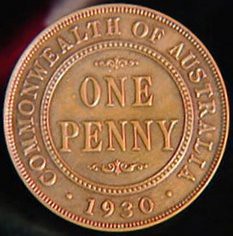 The Proof 1930 Australian copper penny is internationally renowned as the most valuably copper coin of the modern era through its exceptional quality and the circumstances of its striking. One of the original six pennies has just been offered for private sale, expected to sell for around two million dollars. However some experts have questioned the coin's advertised provenance as the Mint Master's coin.
The Proof 1930 Australian copper penny is internationally renowned as the most valuably copper coin of the modern era through its exceptional quality and the circumstances of its striking. One of the original six pennies has just been offered for private sale, expected to sell for around two million dollars. However some experts have questioned the coin's advertised provenance as the Mint Master's coin.
KERRY O'BRIEN, PRESENTER: Here is a story about the value of things past. An Australian penny that's known as the king of this country's rare coins, even internationally renowned as the most valuable copper coin of the era, the proof 1930 penny struck purely as a showpiece by the Melbourne mint at the height of the Great Depression has acquired legendary status, both for its exceptional quality and the circumstances of its striking. Just three of the original set of six proof '30 pennies are in private hands, and the one rare coin aficionados consider see as the pick of the bunch has just been offered for private sale. The coin is predicted to fetch as much as $2 million, which would be a world record. But some rare coin experts have questioned the legitimacy of the coin's advertised provenance as the mint master's coin. Tracee Hutchison reports.
ROBERT JACKMAN: Being the mint master's coin, so to speak, the one that he chose actually even adds a larger and a better air to it, because that really gives it even more authenticity and attention that people love to have when they're buying rarities.
BELINDA DOWNIE: The striking of proof coins was actually at the discretion of the deputy master of the mint. In this particular instance, Le Souef was a passionate collector as well. And the fact that Le Souef chose this one has to be affirmation of the quality of the piece, 'cause he could have chosen any of the other five.
TRACEE HUTCHISON: But just how and when that might have occurred is opened to conjecture. According to records in the State Library of Victoria, A.M. Le Souef retired from his position here at the old Melbourne Mint in 1926, four years before the famed '30 penny and proof versions of the coin were struck. Well it's clear Le Souef was a man of great influence during the 1920s, and it was apparently not uncommon for people in his position to be gifted coins, if A.M. Le Souef ever owned a proof 1930 penny, we could find no official record to prove it.
The advertised provenance that Le Souef was the coin's first private owner first appeared in the 1980s. It's been accepted as part of the legend ever since.
TONY BYRNE, FORMER CHIEF NUMISMATIST, ROYAL AUST. MINT: To me, it's just totally incredible. It's almost as if there had to be some sort of unusual practices if he was to have been back in the mint four years later and getting an unrecorded copy of a proof '30 penny. You know? I didn't believe it initially, I don't believe it now.
TRACEE HUTCHISON: Additionally, a comprehensive catalogue of Le Souef's collection compiled in 1986 by the former head of numismatics at Melbourne Museum John Sharples indicates Le Souef stopped collecting in 1928. Two years before the '30 penny was struck. Sharples writes that, "Many coins are wrongly ascribed to him. Over the years, coins ascribed verbally as, 'possibly from the La Souef collection,' have come to be published as, 'from the Le Souef collection'. This is usually in error."
TRACEE HUTCHISON: What is undisputed is the coins provenance to the era's most renowned collector, Sydney Hagley, who wrote in 1950, "My first contact with the 1930 penny occurred about 15 years ago when I acquired a specimen from the Adelaide Gallery duplicates; this was a proof."
TONY BYRNE: In speaking to Hagley, he said the coin had been donated to him by the South Australian gallery in response to his assistance, donations, etc. over the years. So then I couldn't see how Le Souef became involved.
WALTER BLOOM: I can't see that that makes a great difference to the asking price. I mean, this is a rare coin, it is a beautiful coin, and it is very desirable. And that's what's important for a modern coin like the 1930 penny.
TONY BYRNE: To me, the coin stands alone. It's a proof, it's a 1930, it's a magnificent item. It doesn't need prominent people provenance.
To read the earlier E-Sylum article, see: ARTICLE PROFILES COIN DEALER BELINDA DOWNIE (www.coinbooks.org/esylum_v13n42a15.html)
ROYAL MINT STRIKES JOHN LENNON COIN
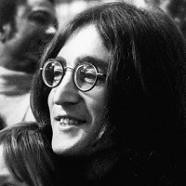 John Lennon has joined the succession of great Britons who have been immortalised on a coin.
John Lennon has joined the succession of great Britons who have been immortalised on a coin.
And although money can't buy you love, the £5 John Lennon coin is now available from the Royal Mint - priced at £44.99.
The Beatles singer, whose hits include Penny Lane, easily won the public vote for the next "Great Briton" to be put on a coin, beating a line-up of historical figures including Jane Austen and John Logie Baird.
To read the complete article, see: Lennon joins great Brits on a coin
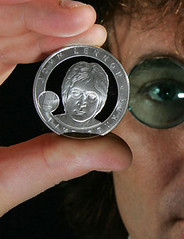
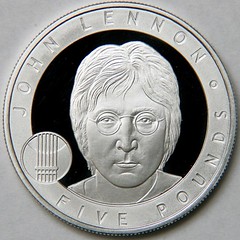
Lennon —whose songwriting credits include "Imagine" and "Strawberry Fields Forever" — came out far ahead of author Jane Austen and several other figures in the balloting.
"It's entirely fitting that John Lennon has been chosen by the public in what would have been his 70th year," said Dave Knight, director of Commemorative Coin at the Royal Mint. "The massive proportion of the vote he received shows clearly just how much his untimely death still resonates with the nation. He ranks alongside, and even ahead of, some of the greatest names in history."
The former Beatle will join William Shakespeare, Winston Churchill, Charles Darwin, Florence Nightingale among British luminaries whose images have graced special coins.
The issuing of the silver commemorative coin marks one more step in the British establishment's posthumous embrace of Lennon, whose political stance and open drug use brought him into conflict with authorities in the late 1960s before he moved to New York, where he was murdered in 1980.
The airport at Lennon's home town of Liverpool has been named after Lennon, and there is a statue of him in the city center.
The limited edition coin shows Lennon with long hair and sideburns and his trademark round glasses. It will have a face value of 5 pounds ($8) but will be sold for 44.99 pounds. Only 5,000 will be offered for sale.
The Royal Mint also plans to produce a single coin in 24 karat gold that will be given to Lennon's estate.
To read the complete article, see: Silver Commemorative John Lennon Coin Issued by United Kingdom Royal Mint (www.artdaily.org/index.asp?int_sec=2&int_new=42172)
SPACE SHUTTLE DISCOVERY CARRIES MEDAL INTO SPACE
 On November 1st, the space shuttle Discovery is scheduled to be launched from NASA'S Kennedy Space Center at Cape Canaveral, Florida. Discovery got its name from one of explorer Captain James Cook's two ships names -- the other was Endeavour -- and a special Captain Cook medal will to be carried by the six-astronaut crew aboard the flight.
On November 1st, the space shuttle Discovery is scheduled to be launched from NASA'S Kennedy Space Center at Cape Canaveral, Florida. Discovery got its name from one of explorer Captain James Cook's two ships names -- the other was Endeavour -- and a special Captain Cook medal will to be carried by the six-astronaut crew aboard the flight.
"We will be carrying a medallion from the [British] Royal Society that was struck in honor of Captain Cook," said NASA astronaut Michael Barratt, who will work as a mission specialist on the upcoming flight. "On Cook's third voyage, there was a ship called Discovery, and that's the main ship for which our ship Discovery took its name."
Discovery also took its name from a ship used by Henry Hudson in the early 1600s in Canada to explore what was eventually named Hudson Bay. Hudson sought out a hoped-for northwest passage between the Atlantic and Pacific Oceans.
Since the time of Hudson and Cook, several other famous ships have been christened "Discovery," and have carried on the strong tradition of exploration. One such vessel was used by the British Royal Geographical Society on an expedition to the North Pole in 1875.
"It's a culmination of a great heritage," Barratt said. "And we hope there are future ships bearing that name."
Captain Cook has been the subject of many medals issued over the years, its a popular collecting specialty among medal collectors.
To read an article on the subject by SPACE.com staff writer Denise Chow, click on:
How Did the Space Shuttle Discovery Get Its Name?
(www.lifeslittlemysteries.com/space-shuttle-
discover-name-101029-1129)
25-YEAR-OLD FRENCH UNDERWATER GOLD THEFT RESOLVED
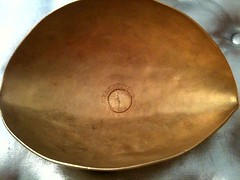 Three amateur divers in 1985 stole a dish of Roman coins and gold from the "treasure of Lava. The testimony of one of the robbers, who was arrested last Thursday.
Three amateur divers in 1985 stole a dish of Roman coins and gold from the "treasure of Lava. The testimony of one of the robbers, who was arrested last Thursday.
After 25 years of investigation, the Department of underwater archaeological research and submarine (DRASSM) of the Ministry of Culture and Communication have laid hands on a dish and Roman gold coins from the "treasure of Lava ".
"I was quietly installed in my place when a dozen police officers arrived. Maybe they were there since the beginning of the trip or did they have benefited from a decision to ride in the wagon. They searched me , handcuffed and took the gold dish. Then they escorted me to the nearest police station, in Nanterre. There, I stayed in police custody three days. It was very stressful, I could not prevent none of my relatives. I was really exhausted, still I remain shocked. "
"We were looking for sea urchins, but that day, the seabed have given us a greater treasure . We stumbled on gold coins, there were between 400 and 600, and an equally sumptuous plate of dating third century. The remains were glued to rocks underwater and we had a Swiss Army knife in his pocket. We are left with the little that we could take, "says Felix.
Aware that they illegally, the three men are discreet. "It was like the guy who wins the lottery one day, we preferred to be silent." But in November 1986, three men are selling their booty in a catalog numismatic and the new one does not take long to spread. "A judicial inquiry was opened in the wake because objects rightfully belong to the French heritage.
To read the complete article, see:
Le mystère du trésor corse enfin percé
(www.lexpress.fr/actualite/societe/le-mystere
-du-tresor-corse-enfin-perce_931628.html
)
BOOK DOMINOES VIDEO
To read the complete article, see: Bookmans Does Book Dominoes (www.youtube.com/watch?v=Pw5LlSKKG3M)
FEATURED WEB SITE: MONEDAS ESPAÑOLAS
This week's Featured Web Site is suggested by Andy Lustig. MARAVEDIS.NET focuses on the money of Spain. It's in Spanish, but there is a link to get a machine-translated version in English.

At present there are more than 6000 types of currencies exhibited and described, in the different sections, from the gold currencies of the visigodos, those of the medieval of Castile and Leon, Aragon, and all the of Spain, as much the peninsular ones kingdoms, as those of the colonies and those of the Spanish European Empire.
www.maravedis.net
